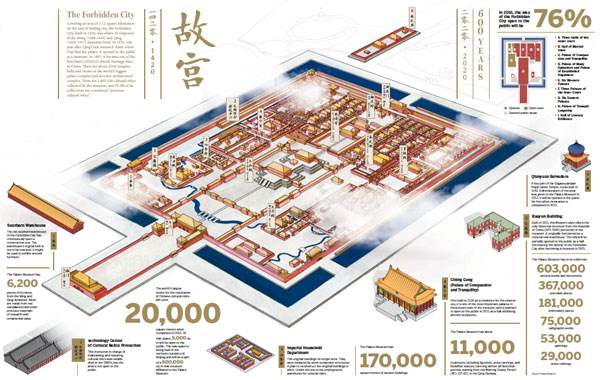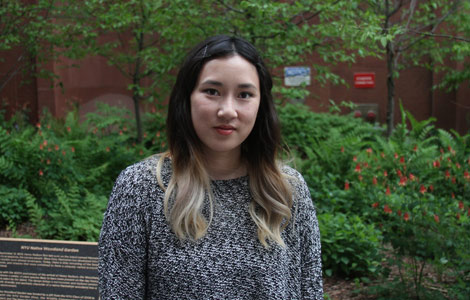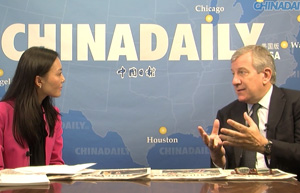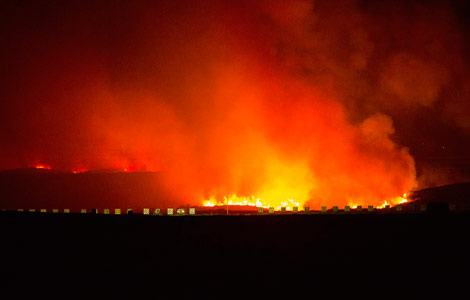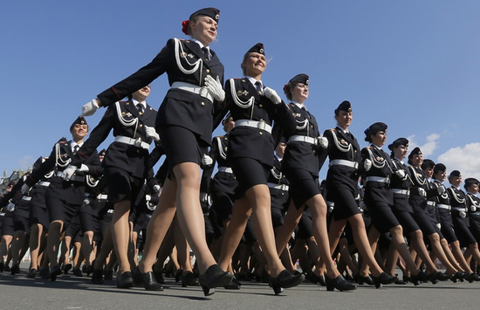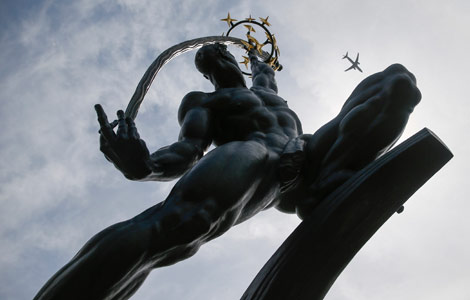Opening up The Palace Museum
Updated: 2014-05-22 06:54
By Wang Kaihao (China Daily)
|
||||||||
The director of the Palace Museum is working tirelessly to improve visitors' experiences at the World Heritage Site and protect its ancient treasures. He talks to Wang Kaihao about his passion for this unique symbol of China.
Shan Jixiang, 60, may have done something never achieved by any of the Forbidden City's former royal residents. After taking the position of director of the Palace Museum in 2012, he has been to all 9,000 temples, halls and rooms in the world's biggest palace complex and wooden architectural complex.
"I can barely take a single day off all year. I have to constantly walk around the palace to scrutinize every corner," a smiling Shan says. "Being the person in charge of such a museum with such complex needs, rich history and intense attention from around the world, you cannot expect to sleep well."
Covering an area of 1.12 square kilometers, the Forbidden City, built in 1420, was home to 24 emperors of the Ming (1368-1644) and Qing (1644-1911) dynasties. In 1925, one year after the last Qing monarch Aisin-Gioro Puyi was forced to leave the palace, it opened to the public as a museum. In 1987, it became one of China's first UNESCO World Heritage Sites.
"No other major museum in the world has equal significance to the layout of a city," Shan says. "I can declare to the world without any exaggeration: This is among the world's top five museums, together with the Louvre, the Metropolitan Museum of Art, the British Museum and the State Hermitage Museum."
He does not hesitate when asked how many cultural relics are kept by the museum - "1,807,558", he says with confidence. He also has accurate statistics on each of the 25 categories of relics, including 53,482 paintings, 75,031 pieces of calligraphy and 159,734 pieces of copper ware. "After a painstaking seven-year detailed survey winding up in 2011, we can finally stop estimating that we own about 1 million pieces," he says.
Shan says about 28,000 manuscripts of poems written by Emperor Qianlong (1711-1799) were recently found in the palace. They were discovered in an unmarked box.
"If someone found even one manuscript of Napoleon Bonaparte, it would probably stir up the whole of the Western world," he says. "So, who knows how many more astonishing secrets are hidden here?"
Cultural relics
The 22,000-square-meter underground warehouse in the Palace Museum was first built in the 1980s. It can hold more than 900,000 cultural relics, which Shan says is not sufficient for modern needs.
"It's unscientific to let different kinds of cultural relics be kept at the same temperature," he explains. "We need a more advanced infrastructure with the best equipment. Our national treasures deserve dignity to live better."
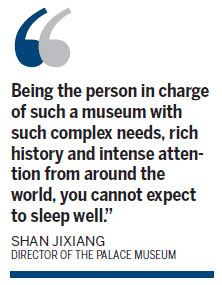
A new project to renovate the warehouse is underway, which will also expand an 8,000-sq-m area and create capacity to hold 400,000 more cultural relics. Many non-exhibited items are now stored separately in different rooms in areas of the museum that are closed to the public.
Shan says applying for a 400 million yuan ($64 million) allocation from the central government was not easy, but he is relieved he is now able to save more relics that had been left exposed in unsafe conditions. "Some large pieces, like sandalwood furniture, finally had chance to shake off the dirt and wait in a nice place to be restored and exhibited."
Restoration of the huge number of relics is made even more difficult due to the shortage of personnel. Shan proudly claims the museum has the world's top professionals restoring Chinese cultural relics, but fire has been banned from use to avoid any danger to the wooden constructions, which has slowed down the working process.
"Nevertheless, we cannot rush. Restoration is responsible for history. To prepare the best exhibits is our primary concern - not time."
A new museum, covering 60 hectares, affiliated to the Palace Museum is being built in the northwestern outskirts of Beijing to increase the space available to do restoration work. Shan says it will become the world's largest hub for Chinese cultural relics' restoration, and the work sites will be open to visitors. Part of that museum will likely be in operation as early as October.
Safety is also crucial when restoring cultural relics, hence avoiding fire and minimizing the risks posed by natural disasters. Theft is also a major concern.
Shan says armed police will take over the security operations of the museum in the future, and all exhibits in the museum will be equipped with microchips to spot any movement of position.
"All these situations have forced us to build one of the largest central surveillance systems for a museum," he says.
"And cultural relics also have the right to have a rest. That's why our museum now closes on Mondays."
Respecting visitors
The Palace Museum received 15.34 million visitors in 2012, and is the world's only museum whose annual visitor numbers surpasses 10 million. It was once normal to spend at least an hour waiting in line to buy tickets. After Shan ordered all the ticket booths open, the wait period has dramatically reduced.
"After standing in line waiting for over an hour and squeezing into the museum following the crowd, how many people will be in the mood to enjoy the visit?" Shan says. "We should treat visitors with more dignity when they come from afar just to admire our palace."
Shan says the huge volume of visitors brings many challenges.
"But, we cannot increase the entrance fee. Many visitors are from low-income families. We can't shut the door in their face."
The entrance fee is 40 yuan in the lean season and 60 yuan in peak season - much lower than many smaller tourist attractions nationwide.
The museum has cleaned up the square by its front gate and installed hundreds of new seats. Smoking is banned in the entire museum premises. One-seventh of visitors to the Palace Museum come from overseas, so the museum provides an audio guide service in 40 languages.
Perhaps Shan's biggest move has been to open the middle front gate, which was traditionally only opened for emperors, and in modern times, visiting state leaders.
"Everyone visiting the Palace Museum should be treated equally. They have the right to choose which gate to walk through, as all visitors must enter the museum on foot. The influence of special guests should be minimized."
That was why US first lady Michelle Obama and French president Francois Hollande also entered the museum on foot.
"It is a pity that many visitors only walk through the axis, missing some excellent exhibits scattered in the temples in the two wings," he says. "On one hand, the central part of the museum is too crowded, and on the other hand, some exhibition halls are almost empty. When I walked into an exhibition a few days ago, I only spotted 27 visitors."
More areas in the Forbidden City will be opened to visitors in the coming years.
Only 52 percent of the total area is now open, but the number will rise to 76 percent by the end of 2016. The mysterious part of the western wing - once the home of queens and concubines - will be unveiled to the public for the first time.
Architectural treasure
Shan says opening more areas of the museum is based on renovation currently happening behind closed doors.
"To respect the history, we can only use ancient building materials during renovation to keep the original facades. But modern lightening- and earthquake-precaution methods are also applied."
Shan admits some of his rules for renovation appeared too rigid for his colleagues. But he says they were essential in order to treat the architecture with respect. For example, he did not allow any grass to grow on the walls.
"Of course I cannot promise there will be no grass. But, as long as you allow one blade to exist, there will soon be too much."
There are still some academic institutions and organizations that work inside the Forbidden City. But Shan says it is time for them to leave so there will more space for visitors and the traditional look of the architectural complex can be restored. He says all of these organizations will move out of the palace's red walls by 2016.
"Many new constructions have built in recent decades in the Forbidden City. No matter what function they serve, they must be torn down to give way to the past, and fulfill our duty of maintaining a World Heritage Site."
"I am an architect," says Shan, who was in charge of supervising the Beijing municipal office's urban construction plan. "But all I've done here is demolish buildings.
"By 2020, the 600th birthday of this palace, the only construction left will be historical relics. Then, we will have a Forbidden City of peace and splendor for the next 600 years."
Contact the writer at wangkaihao@chinadaily.com.cn
|
Zhang Ye / China Daily |
(China Daily 05/22/2014 page18)

 'Taken 2' grabs movie box office crown
'Taken 2' grabs movie box office crown
 Rihanna's 'Diamonds' tops UK pop chart
Rihanna's 'Diamonds' tops UK pop chart
 Fans get look at vintage Rolling Stones
Fans get look at vintage Rolling Stones
 Celebrities attend Power of Women event
Celebrities attend Power of Women event
 Ang Lee breaks 'every rule' to make unlikely new Life of Pi film
Ang Lee breaks 'every rule' to make unlikely new Life of Pi film
 Rihanna almost thrown out of nightclub
Rihanna almost thrown out of nightclub
 'Dark Knight' wins weekend box office
'Dark Knight' wins weekend box office
 'Total Recall' stars gather in Beverly Hills
'Total Recall' stars gather in Beverly Hills
Most Viewed
Editor's Picks

|
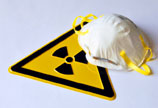
|

|
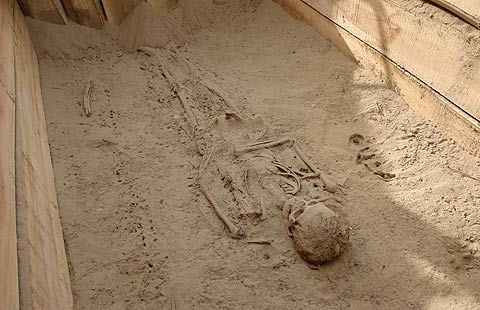
|
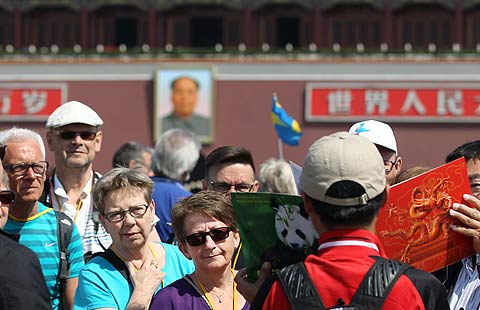
|
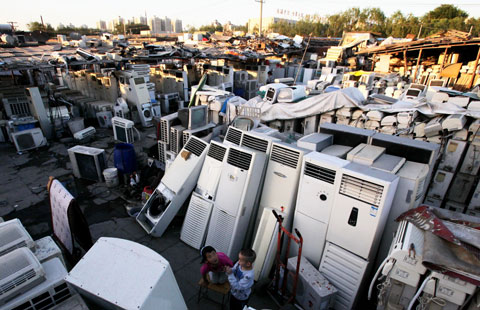
|
Today's Top News
US must 'get used to China's rise'
China outraged over US cybertheft charges
49 deals cement partnership
Indictments flack still festering
Group pushes for memorial
Group pushes for genocide memorial
Chinese national to be sentenced
Win8 ban catches Microsoft off guard
US Weekly

|

|
